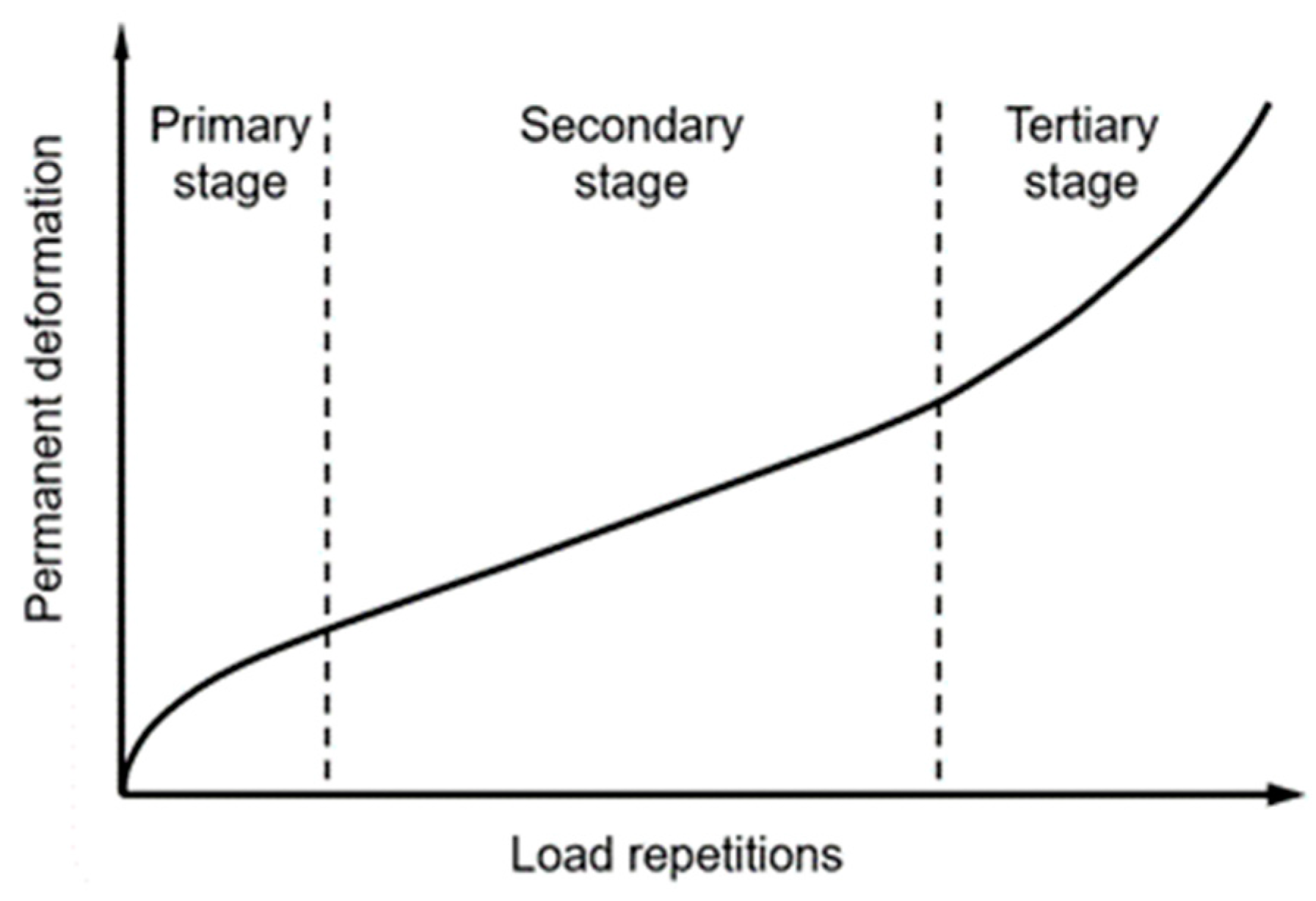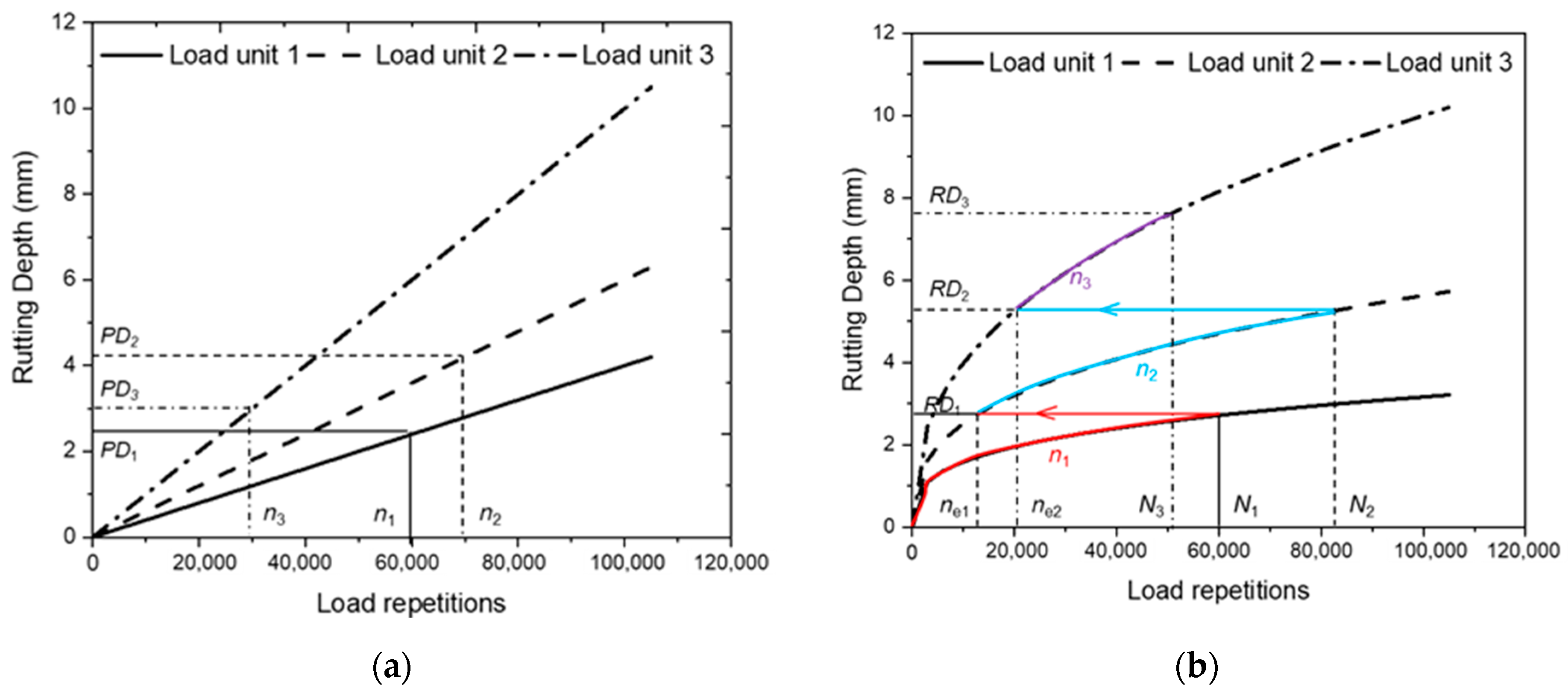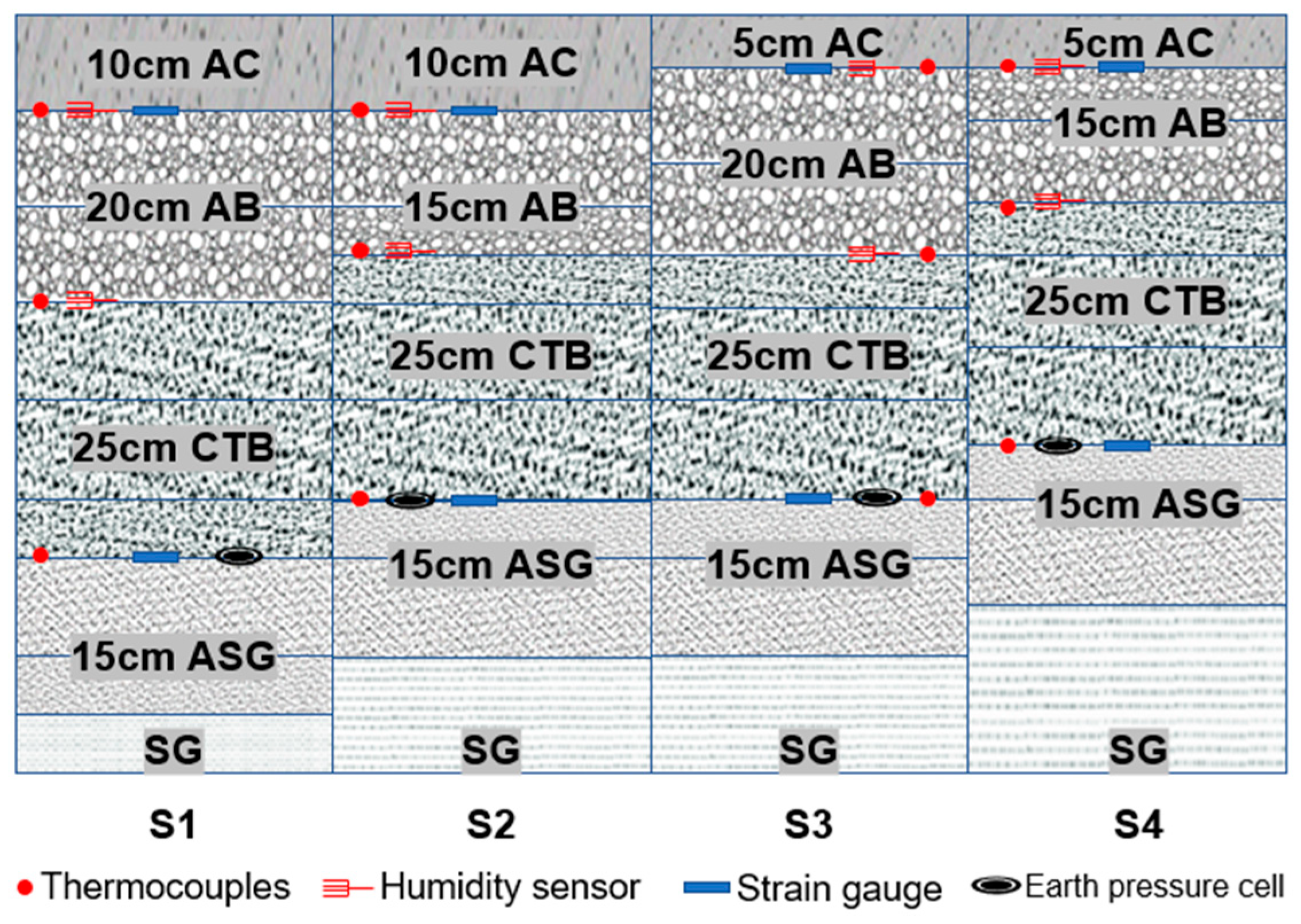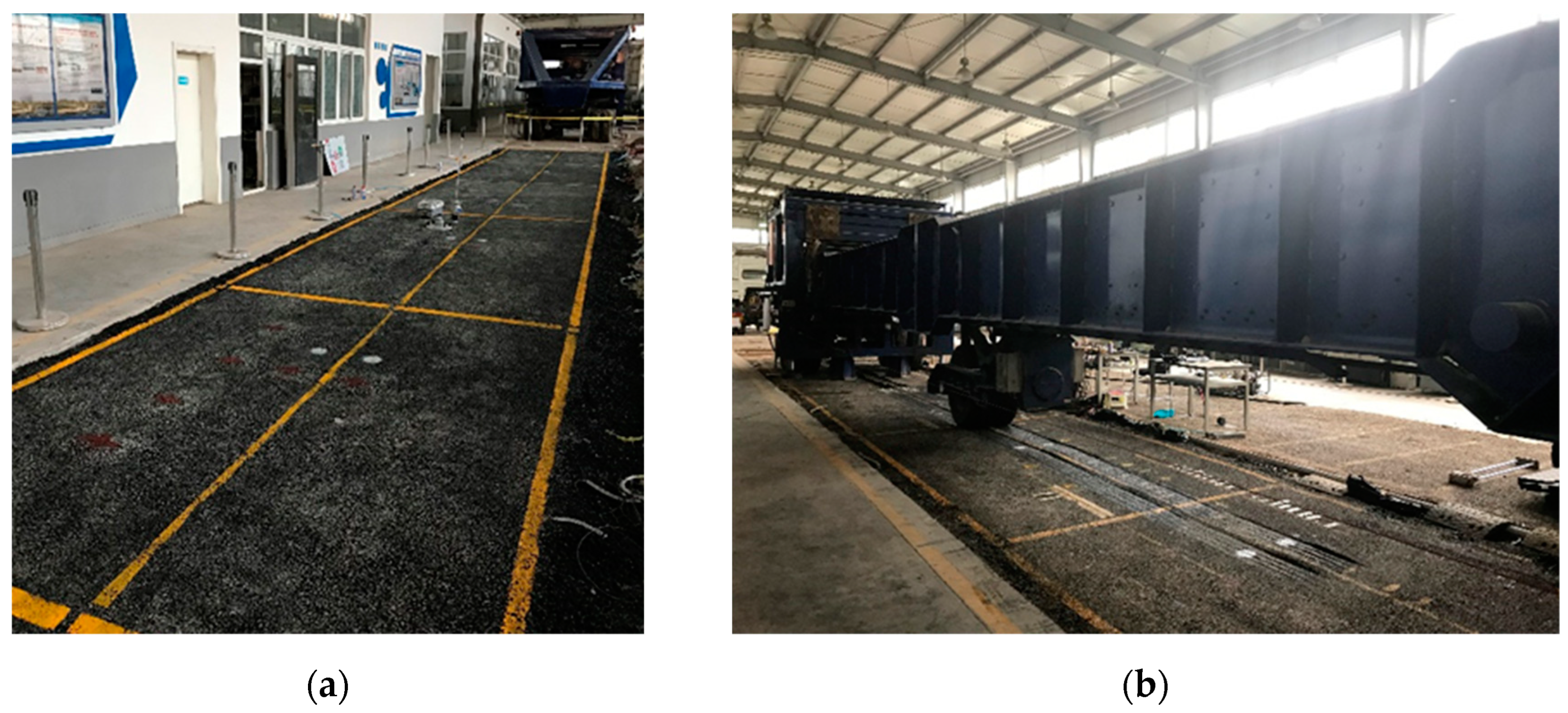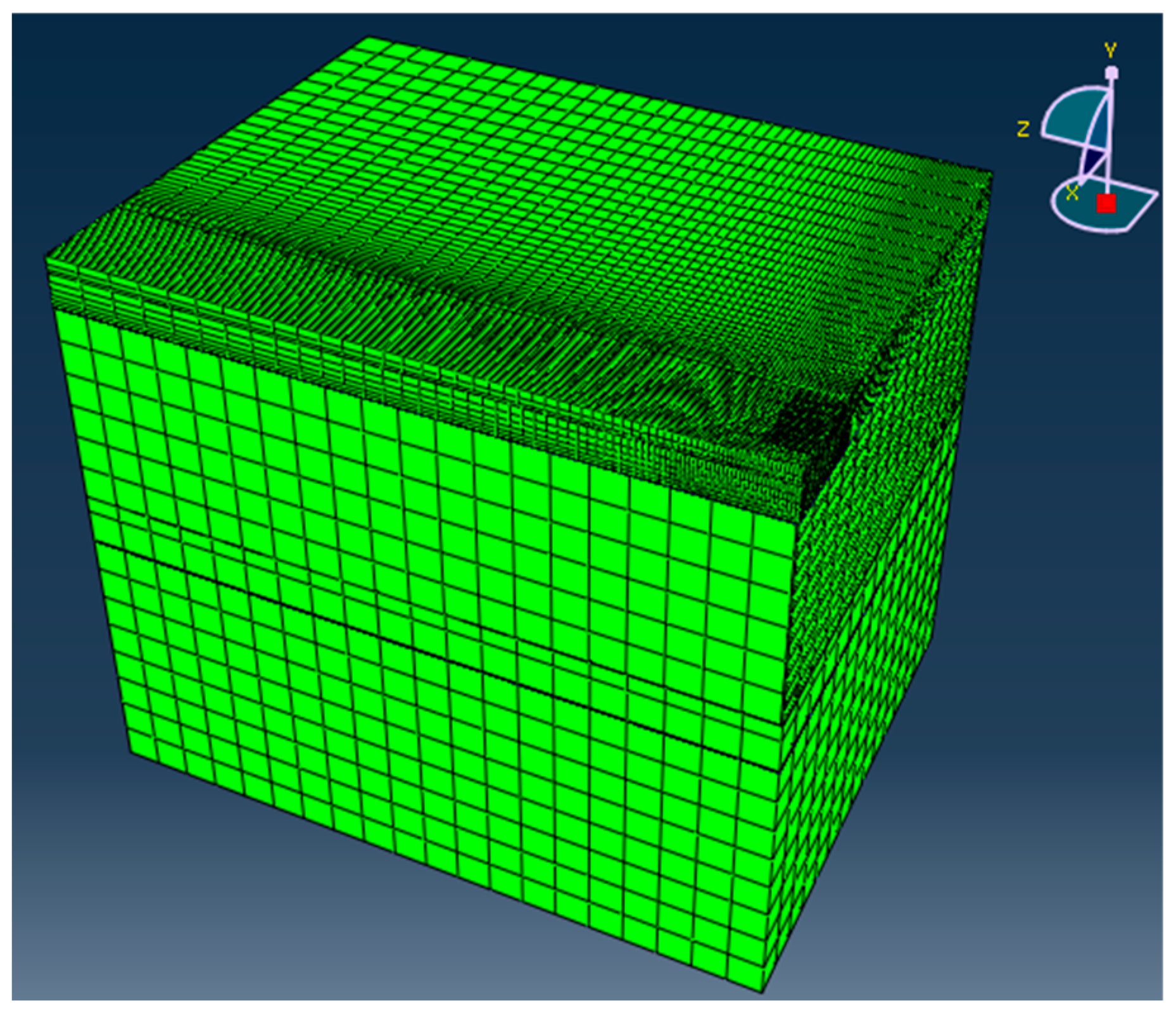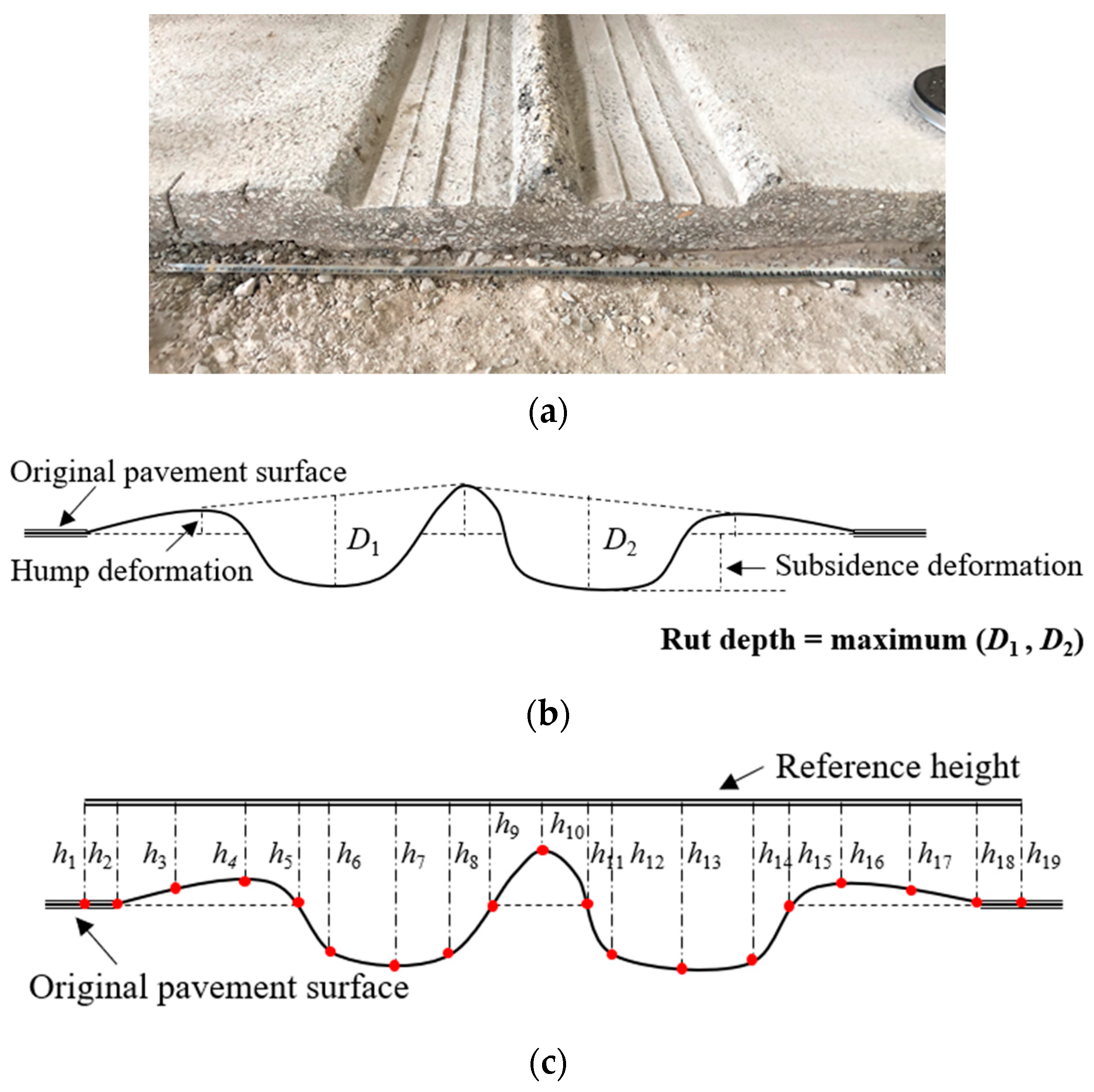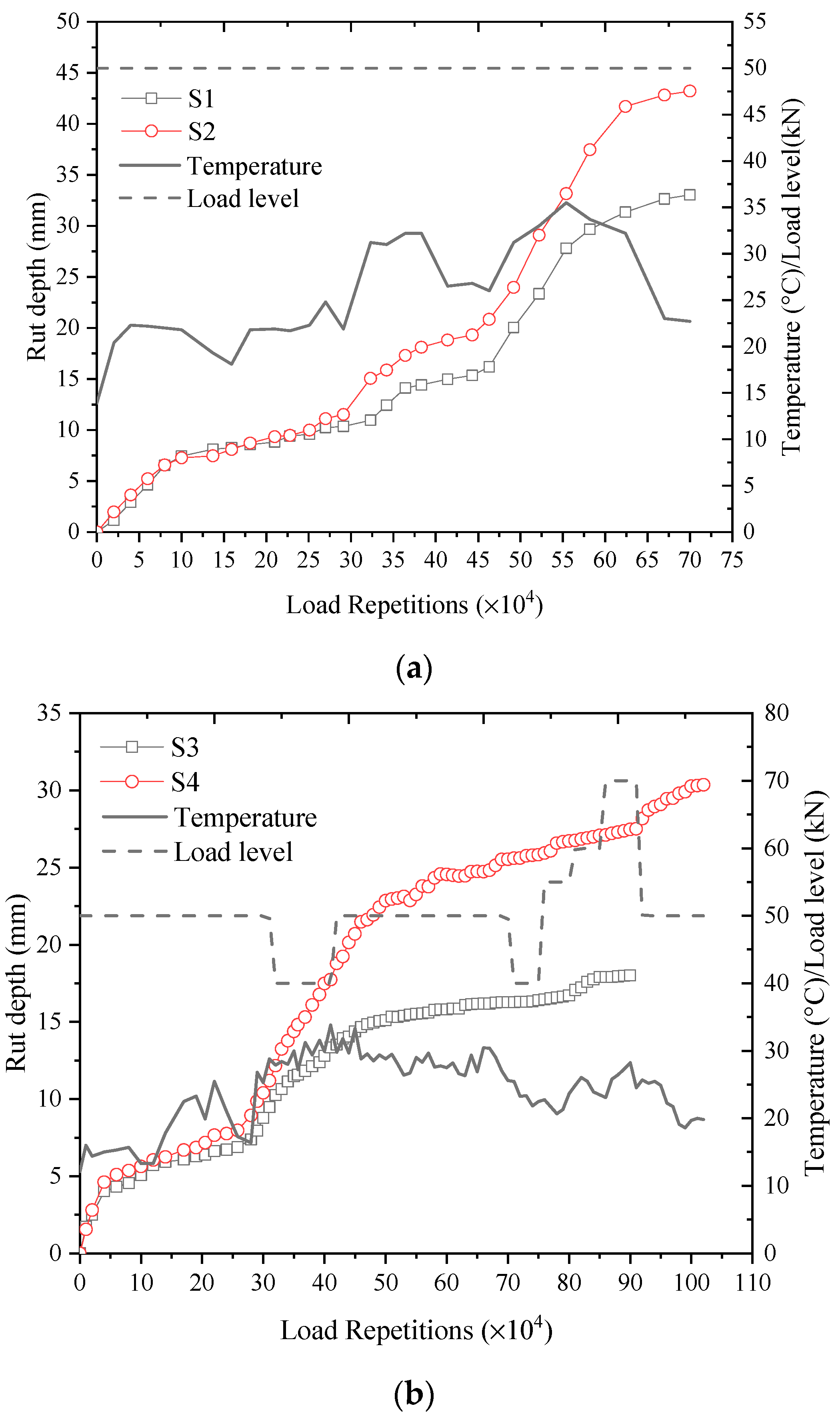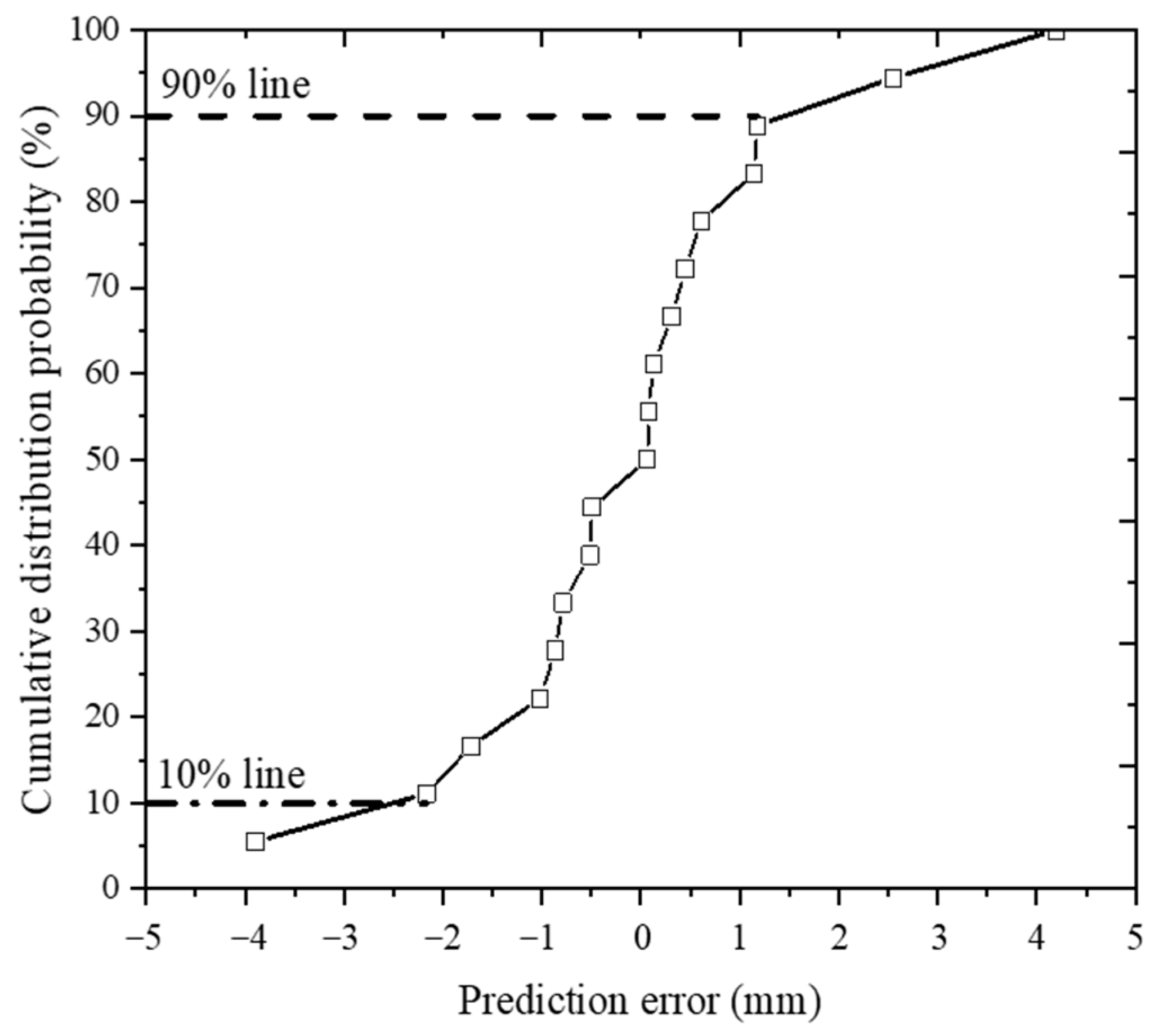1. Introduction
Rutting is a common distress frequently leading to structural failure and traffic safety issues for flexible pavements, and the inverted asphalt pavement (IAP) is especially prone to experience rutting, owing to the relatively weak support of the unbound aggregate base [
1,
2]. Generally, rutting is defined as the longitudinal surface depression along the wheel path and is characterized by the parameter of the rut depth (RD) [
3,
4]. Surface water, such as rainwater, tends to accumulate in the rutted portion of the pavement, which makes steering difficult and results in the hydroplaning of vehicles. Additionally, a reduced asphalt concrete (AC) layer thickness in the rutted portion may accelerate the progression of fatigue cracking and other pavement failures. To help highway agencies with proper work planning and budget allocation, accurate and reliable RD prediction models are necessary for the determination of desirable pavement design schemes and maintenance times or measures.
Many types of rut prediction models have been developed since the AASHO Road Test, in the late 1950s, during which large numbers of test data were available for model establishment [
5]. At the early stage, laboratory specimen test results are normally used to build the empirical rut prediction models [
6,
7]. However, lab tests illustrate obvious differences, compared with field tests, regarding the size effect, boundary condition, and stress state, making the empirical models difficult to meet the accuracy requirement of engineering practice. Therefore, field projects, such as West Track, Mn/ROAD, and in-service pavements, were gradually developed and utilized to build the rut prediction model under real engineering application conditions [
8,
9,
10,
11]. Mechanistic-empirically (M-E) based accumulative permanent strain or deformation prediction models were established with variables, such as the number of load repetitions, temperature, layer stiffness, layer thickness, vertical strains, and shear strains [
12,
13]. The models are usually constructed and regressed, based on laboratory test results, then verified or calibrated with field test results [
8,
9,
14]. However, complicated traffic load distribution and environment condition variations of the filed pavements require simplified assumptions for the verification or calibration phases, which affects the reliability of the acquired models.
The accelerated pavement testing (APT) technique emerges as the research requires, which aims to apply continuous wheel loads on full-scale test sections under controlled load and environmental conditions, until the structure fails within a short period of time [
15,
16]. Researchers from Australia [
17], South Africa [
18], the United States [
19], France [
20], Brazil [
21], Costa Rica [
22], and so on, have contributed a lot to the field over the last decades. Research results can be found in the long-term performance evaluations [
23,
24,
25,
26] and distress mechanism investigations [
27,
28] of pavement materials and structures, based on the APT technique, whereas there are lacking studies on the calibration methods of rut prediction models under complex test conditions, based on APT. Hence, calibrated M-E models, recommended in the design guide or provided by similar projects, are commonly used for IAPs in current research and engineering practice [
29,
30], which may not be applicable to the variety of pavement material types, structural combination, environment, and traffic characteristics of the local projects. Moreover, an accumulative RD analysis and prediction model construction generally utilizes Miner’s law [
31], in which the linear superposition principle of this theory fails to include the impacts of the pavement material’s nonlinearity and loading history on the rut progression.
This study develops the calibration method of the RD prediction model for asphalt pavements, based on full-scale APT under complex loading conditions. The approach of introducing the APT, resulting in the calibration process and the rut analysis principle, and considering the effects of the material’s nonlinearity, test condition variations, and loading history on the rut accumulation, are investigated. Utilizing the test data obtained from APT of four IAP test sections using a heavy vehicle simulator (HVS), this study demonstrates and validates the proposed calibration method, and establishes the RD prediction model of IAPs under a full-scale APT condition.
4. Calibration of the IAP Rut Prediction Model, Based on Full-Scale APT
To demonstrate the application method and feasibility of the proposed model calibration method for engineering practices, the RD prediction model of the IAP is calibrated using the full-scale APT results of the four test sections. The primary task of model calibration is to determine the prediction model shift function (Equation (6)) once the material and temperature related model coefficients were determined. The measured RD progression history, back-calculated layer moduli, representative layer temperature, and FE model calculated pavement responses of test sections S1-S4 during the APT, are used to calibrate and determine the model coefficients.
4.1. Calibration in the Initial Load Units
As the model calibration is based on a nonlinear incremental recursive method, the rutting equivalent load repetitions
ne,p need to be solved to recurse the calibration process from the current load unit to the next. However, the initial unit is calibrated without computing
ne,p, as no damage or deformation are accumulated before this. Therefore, the RD test results after the different load repetitions in the initial load units of S1, S2, S3, S4 are used to preliminarily calibrate the model shown in Equation (5). Coefficients
a and
b were determined according to the flow number tests, and
RSF could be further calculated, based on the regression results, which is presented in
Table 3. Thereafter, the coefficients in Equation (6) can be regressed using the back-calculated layer moduli and computed maximum compressive strains in the initial load units, illustrated in
Table 4. Accordingly, the RSF function and RD prediction model can be initially determined as Equations (10) and (11), respectively.
However, the RSF is significantly affected by the pavement structure dimensional effect, boundary condition, stress state, axle load level, and ambient temperature compared to the lab tests. The APT data of the full-scale test sections under a more diversified load and temperature conditions is necessary for more precise and reliable model calibration results. Therefore, RSF will be further calibrated utilizing the test data from the consecutive load units of S1–S4.
4.2. Calibration in the Consecutive Load Units
Various ambient temperature conditions and 40–70 kN half axle dual-wheel loads are set in the consecutive HVS APT load units of test sections S1–S4. The test data of those load units can be used to further calibrate the prediction model. Taking test section S3 as an example, the model calibration method and process, based on the APT results and the nonlinear IR principle are described, as follows. The calibration of the consecutive load units of other test sections is similar to that of S3.
4.2.1. Model Calibration in the Second Load Unit
Half axle load of 40 kN and the representative temperature of 30.2 °C at the middle depth of the AC layer are adopted in the load unit S3-2. The rutting growth law will change, owing to the change of the load level, temperature, and pavement responses, compared to the previous load unit. Hence, to recurse the calibration process from S3-1 to S3-2, the RELR
ne1 completing the RD of S3-1 with the rutting growth law in unit S3-2 needs to be solved, firstly.
ne1 can be calculated, according to Equation (12) using the representative layer moduli, representative AC temperature, and maximum compressive strain in unit S3-2, as well as the RD at the end of unit S3-1. The average of all measured results in unit S3-2 are adopted as the representative layer moduli and temperature. Then, the maximum compressive strain on top of the subgrade can be computed, based on the representative layer moduli, layer thicknesses, and axle load level using the formerly developed FE model [
34]. The parameters determination method is the same for other load units and the parameter calculation results of the consecutive load units are presented in
Table 5.
where
RD1 is the accumulative rut depth at the end of load unit S3-1;
Ea2,
T2, and
εv2 are the representative modulus and temperature of the AC layer and the representative maximum compressive strain on top of the subgrade in load unit S3-2, respectively.
The equivalent cumulative load repetition (
ne1 +
n) in load unit S3-2 can be obtained after
ne1 is determined as 135,869. Subsequently, the prediction model regression analysis can be conducted, according to Equation (13) utilizing the measured RD data and representative AC layer temperature after the different load repetitions in load unit S3-2. The regressed
RSF and the corresponding regression determination coefficient are 0.0694 and 0.9291, respectively, which are documented in
Table 5.
4.2.2. Model Calibration in the Third Load Unit
The third load unit S3-3 adopts the 50 kN dual-wheel load and 28.0 °C representative AC layer temperature. Firstly, the RELR
ne2 corresponding to the cumulative RD of load unit S3-2 is calculated using Equation (14). The parameters used in the calculation can be found in
Table 5.
where
RD2 is the accumulative rut depth at the end of load unit S3-2;
Ea3,
T3, and
εv3 are the representative modulus and temperature of the AC layer and the representative maximum compressive strain on top of the subgrade in load unit S3-3, respectively.
The calculation result of
ne2 is 351,161, and the equivalent cumulative load repetition in load unit S3-3 can be updated as (
ne2 +
n) afterward. Thereafter, the regression analysis of the RD prediction model is carried out according to Equation (15) using the measured RD and representative AC layer temperature after different load repetitions in unit S3-3. The calculated
RSF and the corresponding regression determination coefficient are 0.0663 and 0.9502, respectively.
4.2.3. Model Calibration in the ith Load Unit
Firstly, the rutting equivalent load repetition
ne,i−1 corresponding to the cumulative
RD of load unit S3-(
i−1), should be calculated according to Equation (16). The parameters involved in the calculation can be found in
Table 5.
where
RDi−1 is the accumulative rut depth at the end of load unit S3-(
i−1);
Eai,
Ti, and
εvi are the representative modulus and temperature of the AC layer and the representative maximum compressive strain on top of the subgrade in load unit S3-
i, respectively.
The rutting equivalent cumulative load repetitions in load unit S3-
i could be updated as (
ne,i−1 +
n) once
ne,i−1 is determined. Subsequently, the RD prediction model could be regressed, according to Equation (17) using the measured RD and representative AC layer temperature after different load repetitions in load unit S3-
i to determine the
RSF.
The total number of load units can be determined, based on the loading history division results of the different test sections. According to the above calibration method, the test data from other consecutive load units of S1–S4 can be utilized to further calibrate the
RSF, and the corresponding calibration results are shown in
Table 6. Then, the shift function can be calibrated, according to Equation (6). However, the AC layer thickness is found to have a significant influence on the rutting development [
35]. Therefore, the item of the AC layer thickness ha is added in the shift function, and the measured AC layer thicknesses of test sections S1–S4 during the APT are used for calibration. The parameter calculation results and
RSF calibration results using test data from the consecutive load units of S1–S4 are presented in
Table 6.
Consequently, the shift function shown in Equation (18) can be obtained after the model calibration using the APT data of the four full-scale IAP test sections, and the prediction model of the RD at the end of the
ith APT load unit can be determined as Equation (19). The calibration method and process can be illustrated as the diagram shown in
Figure 8. The calibration method is developed, based on the results of the lab test and multi-units full-scale APT utilizing the nonlinear IR principle. By altering the lab test and APT setup, the method and process illustrated in
Figure 8 could be used for the establishment and calibration of other performance prediction models of asphalt pavements.
where
RDAPT,i is the predicted accumulative rut depth at the end of the
ith load unit;
Ti,
Eai,
hai, and
εvi are the representative temperature, modulus, and thickness of the AC layer, and the representative maximum compressive strain on top of the subgrade in the
ith load unit, respectively;
ne,i−1 is the rutting equivalent load repetition corresponding to
RDAPT,i−1;
ni is the load repetition in the
ith load unit.
4.3. Evaluation of the Calibrated RD Prediction Model
To evaluate the validity and reliability of the calibrated RD prediction model shown in Equation (19), the cumulative RD at the end of the different load units of test sections S1–S4 are predicted, based on the representative temperature, representative layer moduli, AC layer thickness at the beginning of the unit, and the representative FEM computed maximum compressive strain on top of the subgrade of the different load units. The parameters utilized in the calculation of the predicted cumulative RD can be found in
Table 3,
Table 4,
Table 5 and
Table 6. The predicted cumulative RD results are compared with the corresponding measured data, and the prediction errors are determined and illustrated in
Table 7, which ranges from −3.9 to 4.2 mm. Moreover, the cumulative probability distribution curve of the prediction errors presented in
Figure 9 shows that 80% of the errors are in the range of −2.16–1.18 mm, indicating relatively stable and reliable prediction results of the calibrated model. Therefore, the calibrated RD prediction model could be utilized for the design and maintenance of IAPs. The proposed calibration method of the RD prediction model could be a useful reference for the determination of the asphalt pavement performance prediction models.
5. Conclusions
The study aims to develop the calibration method for the rut prediction model of IAPs, based on full-scale APT. The nonlinear IR principle was used for the accumulative RD analysis, and a power type RD prediction model was established, according to the typical rut progression law of flexible pavements. The shift function of the RD prediction model from the lab specimen tests to full-scale APT conditions was developed to introduce the full-scale pavement performance test data to the calibration process. Four full-scale IAP test sections were constructed and instrumented to facilitate the model calibration. The APT with 700,000 and 900,000 repetitions of HVS loads were applied on test sections S1–S2 and S3–S4, respectively. The RD measurements and FWD tests were carried out on the test sections after every 20,000 load repetitions. The RD prediction model of IAPs was calibrated using the measured APT data, illustrating the prediction error mainly ranging from −2.16 mm to 1.18 mm. The conclusions obtained from the model calibration process are listed as follows:
(1) Compared with the traditional linear permanent deformation analysis method based on Miner’s law, the IR principle could better consider the impact of the pavement material’s nonlinear property, complex loading history, and environment conditions on the RD accumulation. The IR based analysis method is conducive to improving the reliability and accuracy of the RD prediction by better replicating the rutting development process of the actual flexible pavements.
(2) The shift function linking the RD prediction models derived from the lab tests and field tests is essential for the model calibration based on APT, which can be constructed with parameters reflecting the primary difference of the different test conditions. The loading history division and model parameter determination methods provide the basis for the model calibration method, based on full-scale APT and the nonlinear IR principle. The proposed calibration method could be used as a reference for the establishment of the RD prediction model of flexible pavements.
(3) The RD prediction model of IAPs is calibrated using small-scale specimen tests and full-scale APT. The calibrated model can be used for the RD prediction of IAPs with other design schemes, by updating the material-related coefficients and the corresponding FE models, which is convenient for engineers to apply in various local projects.
(4) More IAP test sections with different design schemes will be constructed for HVS APT to further calibrate the RD prediction model obtained in the study, and the long-term performance data of the filed IAP will be collected to develop the shift function from full-scale APT to the filed in-service pavement condition.
